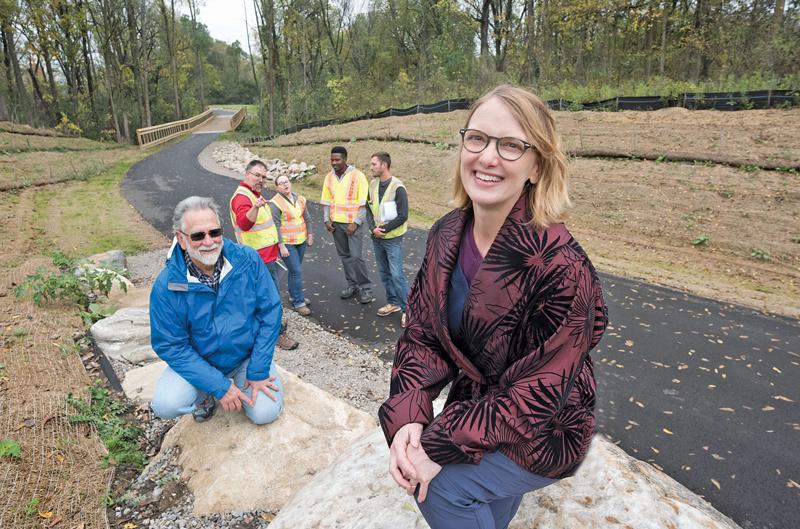Sikkenga, associate director of the U-M’s Matthaei Botanical Gardens and Nichols Arboretum, used to live near Packard and Stadium. An avid biker, she’d sometimes ride to work at Matthaei. She could pedal safely most of the way–through the Burns Park neighborhood, out Devonshire Rd. to Gallup Park, and then along the county’s Border-to-Border Trail to Parker Mill. But the last two miles up Dixboro Rd. were harrowing: “no shoulder, no sidewalk, and the speed limit is forty-five.”
Matthaei has more than four miles of hiking trails, but unless people drive a car, Sikkenga says, there was no safe way to get to them: “There were no nonmotorized options.”
Now there are: in October, she celebrated the completion of a two-mile walking-biking path connecting the gardens to Parker Mill. The Matthaei Botanical Gardens Trail brings bikers and walkers to the gardens with much more ease and safety–and not only that, says Sikkenga, “it’s a beautiful design.”
Brian Barrick at Beckett & Raeder, did the conceptual design. “He cared about the signature trees,” she says. “He created a sense of discovery.
But before Barrick could do that, lots of money had to be raised. Grants had to be sponsored, written, and submitted. University and state officials had to be brought into the decision-making. Sikkenga’s boss, Bob Grese, warned her that it was such a difficult task that when it was first attempted years ago, it failed.
But in addition to a bicyclist’s understanding of how much the trail was needed, Sikkenga had a master’s in public policy and administration and years of experience in local government consulting as budget and finance manager for U-M’s LS&A. “I’d been at the U for sixteen years and understand university operations.”
Still, it turned out to be even more complicated than she thought. In addition to the gardens and the neighboring U-M Leadership Challenge Course and Radrick Farms golf course–run respectively by the student life and athletics offices–she had to get the U-M planning, government relations, risk management, and public safety units on board, as well as the U’s Department of Public Safety and Ann Arbor Township. Getting a “perpetual easement” for the trail proved particularly challenging, because “MDOT was adamant” that the trail had to be permanent, but the university didn’t want to rule out future projects along its path. It ended up being “written that there will be a trail, but [the easement] gives the U flexibility to move it as long as the starting point and ending point remains the same.”
It helped that a walking-biking path fit the goals of the university and the Matthaei family, which donated all of the property it passes through. And as the project unfolded, Sikkenga says, Mike Moran, the Ann Arbor Township supervisor, became “a real partner,” applying for grants that weren’t available to the university.
U-M provided fundraising support; NSF International and Toyota, which have facilities nearby, were “significant contributors,” joined by Matthaei family members and more than 150 other individual donors. Grants from MDOT, the township, the DNR, and others brought the total raised to $3.3 million for a project that ended up costing $2.4 million. (Most of the extra went back to MDOT, but some went to amenities, Sikkenga says, including extending the trail slightly and adding bike racks.)
A year ago, as the trail was still being built, Sikkenga moved to Huron River Dr. north of Dexter. She’s now twenty miles from the gardens, too far for her to commute by bike. But now that the path is completed, she says, “I have walked it multiple times.”
Like other Matthaei trails, the path will be open to the public year-round, even when it snows. However, there’s a caveat.
“We don’t close them, but we don’t clear them,” Sikkenga explains. If there’s enough snow, though, cross-country skiers may find the Matthaei Trail a nice alternative to the now-closed ski trail at Radrick Farms.


